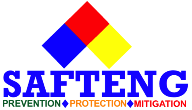Plastics and Flammable Liquids…SAFE?
Nonconductive plastics and other nonconductive materials should be avoided in areas where flammable vapors, gases or powders may be present since static charges can accumulate on nonconductors. However, it is not always possible to completely eliminate nonconductors, so the following lists some of the ways to reduce the static hazard associated with these materials: When…...
Plastics and Flammable Liquids…SAFE? Read More »
